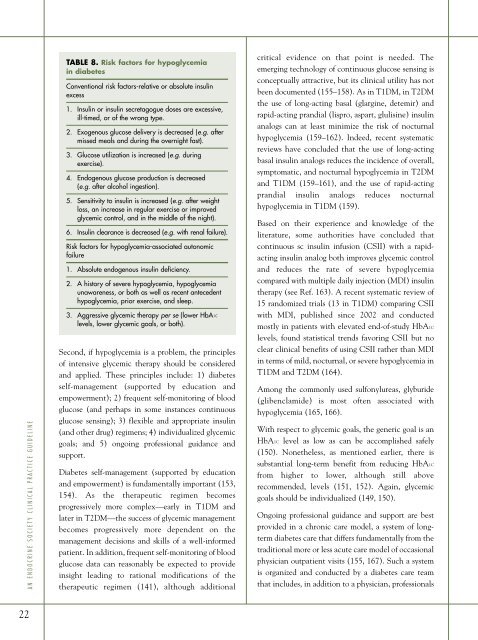Evaluation & Management of Adult Hypoglycemic Disorders
Evaluation & Management of Adult Hypoglycemic Disorders
Evaluation & Management of Adult Hypoglycemic Disorders
You also want an ePaper? Increase the reach of your titles
YUMPU automatically turns print PDFs into web optimized ePapers that Google loves.
AN ENDOCRINE SOCIETY CLINICAL PRACTICE GUIDELINE<br />
22<br />
TABLE 8. Risk factors for hypoglycemia<br />
in diabetes<br />
Conventional risk factors-relative or absolute insulin<br />
excess<br />
1. Insulin or insulin secretagogue doses are excessive,<br />
ill-timed, or <strong>of</strong> the wrong type.<br />
2. Exogenous glucose delivery is decreased (e.g. after<br />
missed meals and during the overnight fast).<br />
3. Glucose utilization is increased (e.g. during<br />
exercise).<br />
4. Endogenous glucose production is decreased<br />
(e.g. after alcohol ingestion).<br />
5. Sensitivity to insulin is increased (e.g. after weight<br />
loss, an increase in regular exercise or improved<br />
glycemic control, and in the middle <strong>of</strong> the night).<br />
6. Insulin clearance is decreased (e.g. with renal failure).<br />
Risk factors for hypoglycemia-associated autonomic<br />
failure<br />
1. Absolute endogenous insulin deficiency.<br />
2. A history <strong>of</strong> severe hypoglycemia, hypoglycemia<br />
unawareness, or both as well as recent antecedent<br />
hypoglycemia, prior exercise, and sleep.<br />
3. Aggressive glycemic therapy per se (lower HbA1C<br />
levels, lower glycemic goals, or both).<br />
Second, if hypoglycemia is a problem, the principles<br />
<strong>of</strong> intensive glycemic therapy should be considered<br />
and applied. These principles include: 1) diabetes<br />
self-management (supported by education and<br />
empowerment); 2) frequent self-monitoring <strong>of</strong> blood<br />
glucose (and perhaps in some instances continuous<br />
glucose sensing); 3) flexible and appropriate insulin<br />
(and other drug) regimens; 4) individualized glycemic<br />
goals; and 5) ongoing pr<strong>of</strong>essional guidance and<br />
support.<br />
Diabetes self-management (supported by education<br />
and empowerment) is fundamentally important (153,<br />
154). As the therapeutic regimen becomes<br />
progressively more complex—early in T1DM and<br />
later in T2DM—the success <strong>of</strong> glycemic management<br />
becomes progressively more dependent on the<br />
management decisions and skills <strong>of</strong> a well-informed<br />
patient. In addition, frequent self-monitoring <strong>of</strong> blood<br />
glucose data can reasonably be expected to provide<br />
insight leading to rational modifications <strong>of</strong> the<br />
therapeutic regimen (141), although additional<br />
critical evidence on that point is needed. The<br />
emerging technology <strong>of</strong> continuous glucose sensing is<br />
conceptually attractive, but its clinical utility has not<br />
been documented (155–158). As in T1DM, in T2DM<br />
the use <strong>of</strong> long-acting basal (glargine, detemir) and<br />
rapid-acting prandial (lispro, aspart, glulisine) insulin<br />
analogs can at least minimize the risk <strong>of</strong> nocturnal<br />
hypoglycemia (159–162). Indeed, recent systematic<br />
reviews have concluded that the use <strong>of</strong> long-acting<br />
basal insulin analogs reduces the incidence <strong>of</strong> overall,<br />
symptomatic, and nocturnal hypoglycemia in T2DM<br />
and T1DM (159–161), and the use <strong>of</strong> rapid-acting<br />
prandial insulin analogs reduces nocturnal<br />
hypoglycemia in T1DM (159).<br />
Based on their experience and knowledge <strong>of</strong> the<br />
literature, some authorities have concluded that<br />
continuous sc insulin infusion (CSII) with a rapidacting<br />
insulin analog both improves glycemic control<br />
and reduces the rate <strong>of</strong> severe hypoglycemia<br />
compared with multiple daily injection (MDI) insulin<br />
therapy (see Ref. 163). A recent systematic review <strong>of</strong><br />
15 randomized trials (13 in T1DM) comparing CSII<br />
with MDI, published since 2002 and conducted<br />
mostly in patients with elevated end-<strong>of</strong>-study HbA1C<br />
levels, found statistical trends favoring CSII but no<br />
clear clinical benefits <strong>of</strong> using CSII rather than MDI<br />
in terms <strong>of</strong> mild, nocturnal, or severe hypoglycemia in<br />
T1DM and T2DM (164).<br />
Among the commonly used sulfonylureas, glyburide<br />
(glibenclamide) is most <strong>of</strong>ten associated with<br />
hypoglycemia (165, 166).<br />
With respect to glycemic goals, the generic goal is an<br />
HbA1C level as low as can be accomplished safely<br />
(150). Nonetheless, as mentioned earlier, there is<br />
substantial long-term benefit from reducing HbA1C<br />
from higher to lower, although still above<br />
recommended, levels (151, 152). Again, glycemic<br />
goals should be individualized (149, 150).<br />
Ongoing pr<strong>of</strong>essional guidance and support are best<br />
provided in a chronic care model, a system <strong>of</strong> longterm<br />
diabetes care that differs fundamentally from the<br />
traditional more or less acute care model <strong>of</strong> occasional<br />
physician outpatient visits (155, 167). Such a system<br />
is organized and conducted by a diabetes care team<br />
that includes, in addition to a physician, pr<strong>of</strong>essionals


